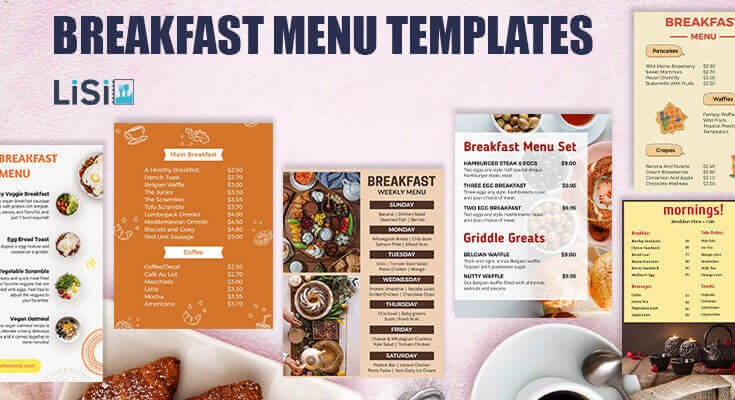A thoughtfully crafted breakfast menu not only highlights your offerings but also influences customer choices and boosts sales. That’s where breakfast menu templates come in. These ready-to-use design tools save time, maintain brand consistency, and make your menu visually appealing and easy to navigate.
In this comprehensive guide, we’ll explore everything you need to know about breakfast menu templates and ideas that not only satisfy your customers but also boost your bottom line.
What is the Breakfast Menu Template?
Simply put, a breakfast menu template is a pre-designed layout that helps restaurants or cafes list their breakfast items. It organizes food and drink options, including:
- Hot items: eggs, omelets, pancakes, waffles, toast, bacon, sausage
- Cold items: cereals, fruits, yogurt, smoothies
- Beverages: coffee, tea, juice, milk, and sometimes specialty drinks like lattes or protein shakes
The breakfast industry has evolved dramatically over the past few years. Moreover, consumer preferences have shifted toward healthier options, convenient ordering, and unique flavor combinations.
Understanding these changes is crucial for creating a breakfast menu that resonates with today’s diners.
What are the Best Breakfast Menu Ideas and Examples?
Ready to create a professional and appetizing breakfast menu for your restaurant? Explore these breakfast menu examples that include all essential design elements, item descriptions, pricing, follow a consistent color scheme, and more.
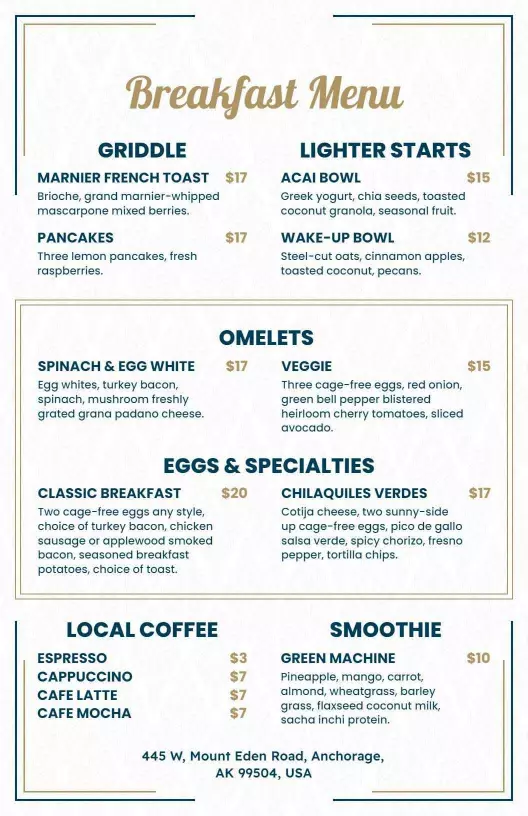
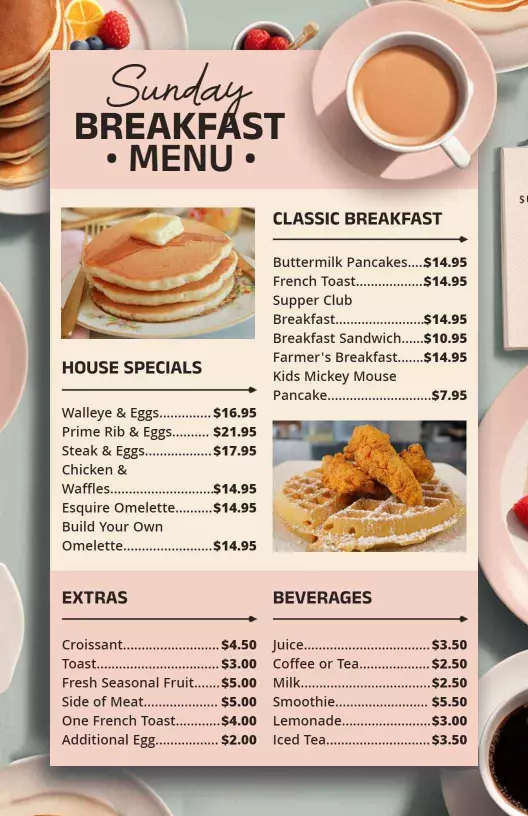
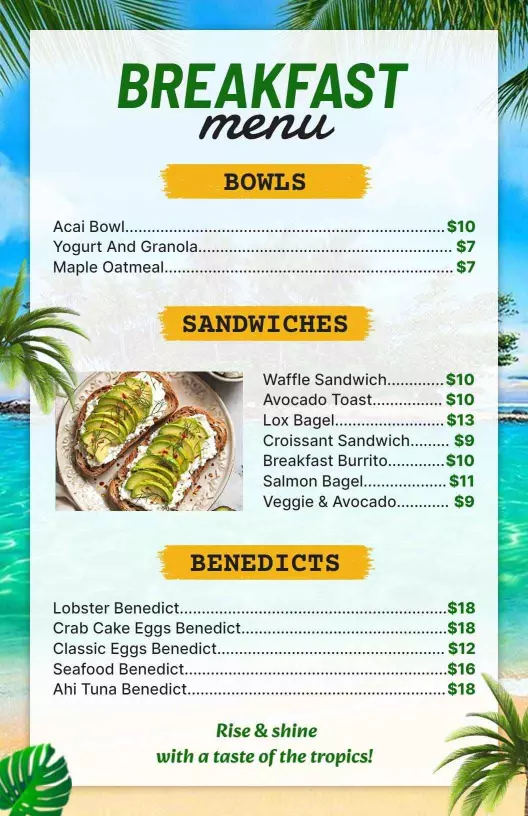
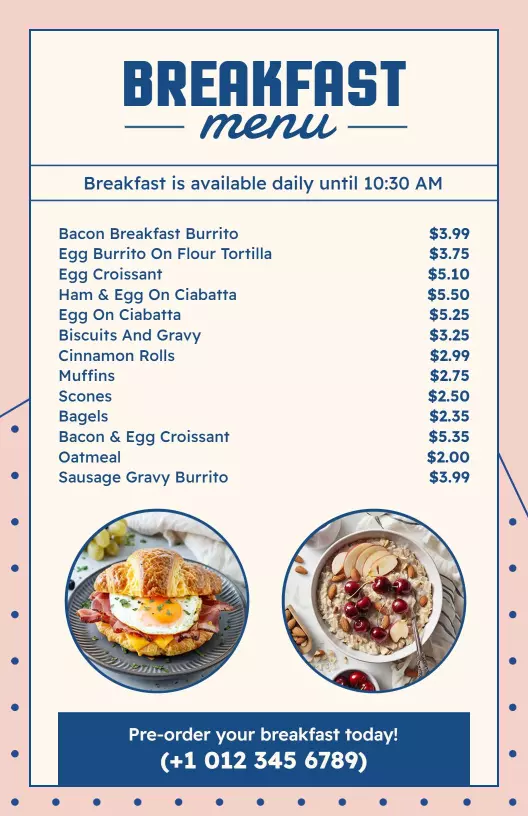
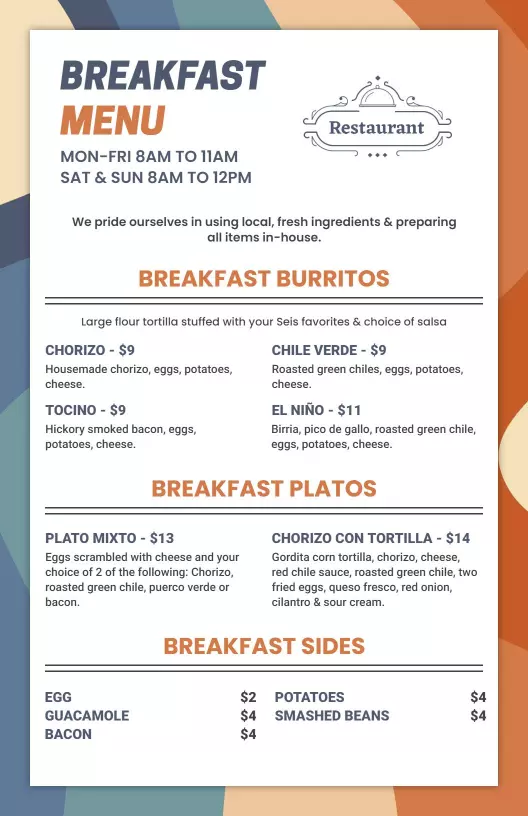
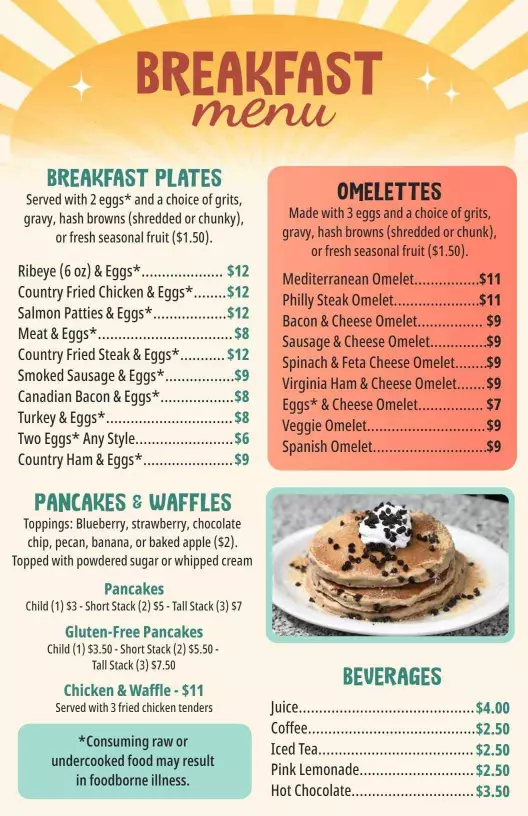
In fact, you can even edit and customize the menu templates easily using many free or paid menu maker apps available online.
What are the Best Practices for Designing a Breakfast Menu that Increases Sales?
Thinking about breakfast menu ideas is easier, but crafting the one that matches the vibe of your restaurant or café and highlights your best dishes is difficult. Below are the best breakfast menu design strategies explained in detail.
1. Keep the Layout Clean and Simple
Your breakfast menu should be easy to read at a glance. Use a clean layout with plenty of white space. Avoid clutter and keep categories well separated, such as “Egg Specials,” “Healthy Choices,” “Hot Beverages,” and “Sides.” A clean design helps customers quickly find what they want without feeling overwhelmed. For example, place the most popular or signature items near the top or in the center of the page, where eyes naturally go first.
2. Use Readable Fonts and Soft Colors
Fonts should be easy to read from a distance, especially in busy morning settings. Choose clear, simple fonts like Sans-serif or Serif styles. Avoid using too many different font types or sizes. When it comes to colors, go for warm and inviting tones like light brown, beige, soft yellow, or pastel orange. These colors are often associated with warmth, morning light, and comfort. Make sure there’s good contrast between text and background so it’s easy on the eyes.
3. Organize Items by Category
Organize menu items into clear sections: “Classic Breakfasts,” “Healthy Picks,” “Kids’ Breakfast,” “Beverages,” etc. This helps customers make decisions faster and encourages them to explore different parts of the menu. If you offer all-day breakfast or brunch specials, place them in a featured section to draw extra attention. A well-structured menu makes the ordering process feel smooth and enjoyable.
4. Use High-Quality Images Sparingly
Photos can make a big impact, especially in breakfast menus where visual appeal is important. Show images of your most attractive and best-selling dishes. However, don’t overcrowd the menu with too many pictures, as it can look cheap or cluttered.
Use high-resolution, professionally taken photos with natural lighting to highlight texture, freshness, and menu card size. For example, a neatly stacked pancake with syrup dripping down is more likely to tempt customers than a plain list of ingredients.
5. Highlight Signature and Best-Selling Items
Use design elements like boxes, icons, or small banners (e.g., “Chef’s Favorite” or “Top Pick”) to highlight your best-selling or signature dishes. This not only draws the eye but also helps undecided customers make quick choices. You can also use bold fonts, different colors, or a shaded background to give emphasis. For example, if your café is known for its avocado toast or French toast combo, give it a little visual spotlight.
6. Include Brief Descriptions and Allergen Notes
A short description under each item can help customers understand what they’re ordering. Keep the language simple and descriptive. For example, instead of just saying “Omelette,” describe it as “Three-egg omelette with cheddar, mushrooms, and spinach.”
Also, include icons or notes for vegetarian, gluten-free, or dairy-free dietary preferences. Clear allergen information builds customer trust and reduces confusion or complaints.
7. Add Personal or Local Touches
Effective pricing balances customer value perception with restaurant profitability. Moreover, breakfast pricing strategies must consider both individual item costs and overall menu dynamics.
Bundle Pricing: Create value-driven combinations that increase average order value:
- Coffee and pastry combinations
- Complete breakfast meal deals
- Family-style sharing platters
- Weekday vs. weekend pricing tiers
Strategic Price Points
- End prices in .95 or .99 to create value perception
- Use whole numbers for premium items to suggest quality
- Group similar items at comparable price points
- Avoid excessive price variations within categories
8. Design for Print and Digital
Many customers today browse menus on their phones before ordering or visiting. So, your menu should be mobile-friendly and easy to view online. Use high contrast, simple formats, and compress file sizes for quick loading. For in-house menus, use quality printing on durable, easy-to-clean material — especially if you serve coffee and sticky items.
If you’re aware of which menu format works best for your restaurant, whether it’s a digital menu or a printed menu, we’ve provided a detailed answer that you must check out.
9. Keep the Menu Short but Complete
While variety is important, too many options can slow decision-making and complicate kitchen operations. Focus on a core selection of breakfast dishes that balance taste, health, and indulgence. Keep the number of items manageable — ideally no more than 20 to 25 — and rotate seasonal or limited-time offerings to keep things fresh.
10. Test, Update, and Improve
Finally, a successful menu is never finished. Regularly review which items are selling well and which aren’t. Ask for feedback from your customers and staff. Make small updates to the design or descriptions to reflect changes in ingredients, pricing, or customer preferences. Even refreshing the look with new icons, colors, or updated photos can breathe new life into your breakfast offerings.
After all, the mentioned breakfast menu examples follow all best practices, and design ideas that you can find as inspiration, and create a breakfast menu that gets more orders.
What Design Elements Make a Breakfast Menu Effective?
Breakfast menus face unique challenges that other meal menus don’t encounter. Moreover, customers often make quick decisions during busy morning hours, making effective design crucial for success.
Therefore, understanding specific design elements for breakfast menus helps you capture more customers and increase sales.
1. Morning-Specific Visual Elements
Breakfast menus should reflect the energy and freshness of morning dining. Additionally, warm colors like golden yellows, soft oranges, and creamy whites create an appetite appeal for morning foods. Furthermore, these colors suggest sunshine, warmth, and comfort that customers associate with good breakfast experiences.
- Color Psychology for Morning Meals: Use colors that make customers feel energized and hungry. However, avoid dark or heavy colors that might seem too intense for early morning viewing. Moreover, incorporate colors that complement coffee, eggs, and other breakfast staples naturally.
- Fresh and Clean Design Approach: Morning customers appreciate clean, uncluttered designs that feel fresh and inviting. Additionally, plenty of white space makes your menu easier to read when customers are still waking up. Therefore, avoid busy patterns or overwhelming graphics that might strain tired eyes.
2. Typography that Works for Early Hours
Morning customers often have limited time and may not be fully alert yet. Consequently, your font choices become even more important for breakfast menus. Therefore, select fonts that remain clear and easy to read under various lighting conditions.
Large, Clear Text: Use fonts that are 20% larger than you might use for designing dinner menus. Moreover, customers viewing menus in early morning light or through drowsy eyes need extra clarity. Additionally, ensure your text contrasts sharply with background colors for maximum readability.
Get your answer here about which typography and color contrast for menu design works well, and generate more takeout sales.
3. Strategic Layout and Structure
Breakfast customers often order quickly and may be in line behind other rushed patrons. Additionally, many breakfast items are familiar to customers, so your layout should help them find favorites fast. Therefore, organize your menu to support quick decision-making.
- The best thing you can do while designing a breakfast menu is to categorize items and group similar items together
- Place your most popular breakfast items at the top of each section.
- Make combo meals and package deals to increase order value
4. Mobile and Digital Considerations
Many breakfast customers check menus on mobile devices while commuting or waiting in line. Additionally, breakfast establishments often rely on online ordering and delivery services. Therefore, ensure you create a digital menu or a QR code menu for breakfast or all courses.
Eve, test your menu design on smartphones to ensure text remains readable and images display properly. Moreover, consider how finger-touch navigation affects menu interaction. Additionally, ensure ordering buttons and links are large enough for easy mobile use.
5. Enticing Food Descriptions
Enticing food descriptions are a powerful part of any effective breakfast menu. They go beyond simply naming the dish—they paint a picture in the customer’s mind and spark appetite. A basic label like “Pancakes” tells you what the dish is, but a description like “Fluffy golden pancakes topped with fresh berries and warm maple syrup” tells a story and makes the item much more appealing.
Good menu descriptions use sensory words that highlight texture, flavor, and aroma—words like “crispy,” “creamy,” “buttery,” or “spiced.” These small details help customers imagine the taste and experience of the dish before even ordering.
6. Consistent Color Scheme
A consistent color scheme is an essential element in effective breakfast menu design because it creates visual harmony and strengthens your brand identity. When colors are used thoughtfully and consistently throughout the menu, they make the layout easier to follow and more pleasing to the eye.
For example, if your café uses soft pastel tones like light yellow, beige, and sky blue, keeping those same colors on the menu helps reinforce a calm, cozy morning vibe.
A consistent color scheme doesn’t just make the menu more attractive; it also builds customer trust by showing attention to detail and professionalism. In short, good color choices set the tone and help guide the customer’s eyes smoothly through the menu.
What Essential Components Every Breakfast Menu Should Include?
Creating a well-balanced breakfast menu requires careful consideration of various categories and options. Additionally, each section should offer choices that appeal to different taste preferences and dietary requirements.
Core Breakfast Menu Categories
Classic Breakfast Items: These timeless favorites form the backbone of most successful breakfast menus:
- Eggs prepared in multiple ways (scrambled, poached, over-easy)
- Pancakes and waffles with various toppings
- French toast with creative presentations
- Traditional breakfast meats (bacon, sausage, ham)
- Fresh fruit and yogurt options
Healthy and Light Options: Modern diners increasingly seek nutritious breakfast choices:
- Smoothie bowls with fresh toppings
- Greek yogurt parfaits with granola
- Avocado toast variations
- Egg white dishes and vegetable omelets
- Fresh juice and smoothie combinations
Hearty and Filling Selections: Some customers prefer substantial meals to start their day:
- Breakfast burritos and wraps
- Hearty breakfast skillets
- Steak and eggs combinations
- Loaded breakfast sandwiches
- Country-style breakfast platters
Beverages and Coffee Program: A strong beverage selection complements your food offerings.
- Specialty coffee drinks and espresso-based beverages
- Fresh-squeezed juices and smoothies
- Tea selections, including herbal and specialty blends
- Seasonal beverage offerings
- Alcoholic options for brunch service
Breakfast Menu Item Development
When developing new breakfast menu items, consider these key factors:
Ingredient Availability and Cost
- Source reliable suppliers for consistent quality
- Calculate food costs and profit margins
- Consider seasonal ingredient fluctuations
- Plan for supply chain disruptions
Kitchen Capacity and Equipment
- Evaluate your kitchen’s ability to prepare complex dishes
- Consider prep time and cooking methods
- Ensure food safety protocols for breakfast service
- Balance hot and cold preparation requirements
Staff Training and Execution
- Develop standardized recipes and procedures
- Train kitchen staff on new preparation techniques
- Create efficient workflow systems
- Establish quality control measures
What are Common Breakfast Menu Design Mistakes to Avoid?
There are many mistakes restaurant owners often make while creating a menu, and some are listed here with proven fixes.
1. Too Many Items on the Menu
A crowded menu can confuse customers. If your breakfast menu includes too many options, people may feel overwhelmed and take longer to decide, or worse, give up.
How to fix it: Keep the menu focused. Highlight your best sellers or unique dishes. A compact, well-organized menu feels more professional and easier to navigate.
2. No Visuals
If every item on your menu looks the same—same font, same size, same color—then nothing stands out. Customers won’t know where to look first. It becomes harder for people to spot your specials or best-selling items.
How to fix it: Use design tricks like bold fonts, boxes, icons, or highlights for key dishes. Group similar items together (e.g., egg dishes, pancakes, drinks). Make the flow feel natural and easy to scan.
3. Missing or Weak Descriptions
Some menus just list item names without any descriptions. This makes it hard for new customers to know what’s inside.
People want to know what they’re ordering. If there’s no info, they might skip the item or ask the staff too many questions.
How to fix it: Add short, clear descriptions with a tempting tone. For example:
“French Toast – Thick slices of brioche soaked in cinnamon-vanilla egg batter, served with maple syrup.”
4. Bad Font Choices or Color Combinations
Using fancy fonts, tiny text, or poor color contrast makes your menu hard to read—especially in morning lighting.
Why it’s a problem:
Customers won’t read what they can’t see clearly, and older guests may struggle the most.
How to fix it:
Use large, easy-to-read fonts. Stick to dark text on a light background for better visibility. Avoid too many colors and distracting patterns.
5. Unclear or Inconsistent Pricing
If prices are difficult to find or unevenly placed across the menu, customers may feel unsure or misled. Customers don’t like surprises when it comes to pricing. If it’s confusing, it creates frustration.
How to fix it: Keep your prices aligned and clearly visible. Use a clean layout where each price is listed next to the item, not scattered or hidden in fine print.
6. No Attention to Dietary Preferences
Today’s diners often look for gluten-free, vegan, or low-sugar options. If your menu doesn’t help them find these, they might leave. Ignoring dietary needs can cost you loyal customers.
How to fix it: Add clear labels (e.g., “V” for vegetarian, “GF” for gluten-free). Offer a few flexible options and mention ingredient swaps where possible. Recommend reading: If you’re running a bar and planning to revamp your existing menu, make sure you aren’t making mistakes while designing your drink menu, and learn best design practices.
What are the Future Trends and Predictions in Breakfast Menus?
Understanding emerging trends helps you stay ahead of the competition and meet evolving customer expectations.
Technology Integration
Generating menus using AI will increasingly help restaurants optimize breakfast menus:
- Predictive analytics for ingredient ordering and menu planning
- Personalized menu recommendations based on customer history
- Dynamic pricing based on demand and ingredient costs
- Automated inventory management and waste reduction
Voice Ordering and Smart Technology
- Integration with smart speakers and voice assistants
- Mobile app pre-ordering with customization options
- Contactless payment and pickup systems
- Smart kitchen equipment for consistent preparation
FAQs about Breakfast Menu
1. What are the essential categories every breakfast menu should include?
A well-balanced breakfast menu should include five core categories to satisfy different customer preferences. First, include classic breakfast items like eggs, pancakes, and bacon that appeal to traditional diners. Second, add healthy options such as smoothie bowls, Greek yogurt parfaits, and avocado toast for health-conscious customers. Third, offer hearty selections like breakfast burritos and skillets for those wanting substantial meals.
2. How many items should I include on my breakfast menu?
The ideal breakfast menu should have 6-8 items per category to avoid overwhelming customers while providing sufficient choice. Research shows that too many options can lead to decision paralysis and slower ordering. Focus on executing fewer items exceptionally well rather than offering an extensive but mediocre selection. For example, include 6-7 main breakfast dishes, 4-5 healthy options, 3-4 beverages, and 2-3 sides.
3. What’s the best way to organize breakfast menu items?
Organize your breakfast menu by following natural customer scanning patterns and meal progression. Start with lighter options like pastries and yogurt, then move to main dishes, and finish with beverages. Within each section, arrange items from lightest to heaviest or from most to least popular. Use clear headings and consistent formatting to guide customers through your offerings.
4. How often should I update my breakfast menu?
Review your breakfast menu quarterly and make updates based on seasonal ingredients, customer feedback, and sales performance. Major menu overhauls should happen 1-2 times per year, while minor adjustments can occur monthly. Seasonal updates keep your menu fresh and take advantage of ingredient availability and pricing.
5. What’s the ideal breakfast menu size and format?
A single-page menu works best for most breakfast operations, as it’s easy to scan and doesn’t overwhelm customers. If you need more space, use a two-panel folded menu that opens to reveal all options at once. Keep the physical size manageable – approximately 8.5″ x 11″ or 8.5″ x 14″ works well.
6. How do I measure the success of my breakfast menu design?
Track key performance indicators, including average order value, item-level sales data, and customer feedback. Monitor which items sell best and which consistently underperform. Analyze order times and customer decision-making speed – a well-designed menu should facilitate quick ordering. Collect customer feedback through surveys, reviews, and staff observations.
Conclusion
We’ve explored the breakfast menu templates and essential elements that contribute to a menu’s success, from understanding your target audience to implementing effective pricing strategies.
A well-designed breakfast menu makes it easy for customers to choose, feel excited about their meal, and enjoy their dining experience. By keeping the layout clear, using simple fonts, adding tempting descriptions, and using consistent colors, you create a menu that not only looks good but also sells better.
A smart menu helps turn a good breakfast into a great one—for both your customers and your business.

